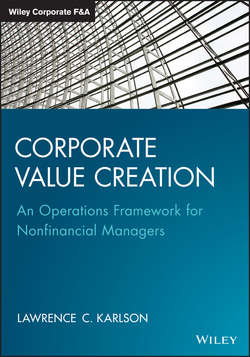Читать книгу Corporate Value Creation - Karlson Lawrence C. - Страница 21
На сайте Литреса книга снята с продажи.
CHAPTER TWO
The Envelope Equations 28
⧉ Incorporating the IR and NiROCE into the Expression for Net Income 41
ОглавлениеTo a significant extent, this book is about Cash Flow since cash is the basic resource required by a business. In the long run Net Income is the only source of cash and so its importance cannot be overemphasized.
Having made an unequivocal statement about the source of cash, the next step in understanding the power of the Envelope Equations is to incorporate IR and ROCE into the Net Income and Cash Flow equations, which is done by starting with the ultimate driver of Cash Flow – Net Income.
The assumptions are: The Net Income for Year n is NIn and during the year the company makes NetInvestn at a rate of IRn of Year n's Net Income. Since it takes time for investments to produce results this investment provides a return of ROCEn + 1 in the following year.42 Given these assumptions and Equation [2-8], the amount of Year n's Net Income invested in assets that will generate future cash flows is:
[2-8]NetInvestn = (NIn)(IRn)
Since NetInvestn provides a return of ROCE(n + 1) the following year, then the Incremental Net Income in Year n + 1 will be:
[2-10]ΔNI(n + 1) = (NetInvestn)(NiROCE(n + 1))
The NI in Year n + 1 is the sum of the NI from Year n and ΔNI in Year n + 1. Therefore, the NI in Year n + 1 is:
[2-11]NI(n + 1) = NIn + ΔNI(n + 1)
Substituting the results of Equation [2-10] into Equation [2-11] creates an expression for NI in terms of NetInvest and ROCE:
[2-12]NI(n + 1) = NIn + (NetInvestn)(NiROCE(n + 1))43
Equation [2-12] is the Second Envelope Equation. It enables the calculation of Any Year's Net Income by simply knowing the Current Year's Net Income, Net Investment, and Net Income Return on Capital Employed, thus enabling the calculation of the Cash Flow after Investing Activities for the year in question.
The Investment Rate IR can be incorporated into Equation [2-12] by substituting the results of Equation [2-8] for the term NetInvest in Equation [2-12].
[2-13]NI(n + 1) = NIn + (NIn)(IRn)(NiROCE(n + 1))
Factoring [2-13] gives an equation that defines NI in terms of IR and NiROCE.
[2-14]NI(n + 1) = (NIn)[1 + (IRn)(NiROCE(n + 1))]
Equation [2-14] is the Third Envelope Equation and differs from Equation [2-12] in the sense that it calculates a Future Year's Net Income by using the Current Year's Net Income in combination with the Investment Rate and Net income Return on Capital Employed.
In Year n + 1, investments are also being made and the magnitude of the NetInvest in Year n + 1 is:
[2-15]NetInvest(n + 1) = (NI(n + 1))(IR(n + 1))
which will prove to be a useful expression when estimating the Incremental Net Income and so forth in Year n + 2.
Equations [2-12] and [2-14] are powerful tools for doing quick estimates of a stream of Net Incomes that are the result of investments with expected returns. These equations together with Equation [2-8] constitute three of a set of five equations that are useful for predicting Net Income. The other two equations have to do with Cash Flow. They will be derived in the following section.
42
This is an important set of assumptions, especially the notion of NetInvestn providing a Net Income Return on Capital Employed of NiROCEn + 1 the following year.
43
It is important to understand the basis for this equation as well as [2-13] and [2-14]. The Net Income in Year n + 1 is the sum of the Net Income in Year n and the incremental Net Income is generated by the Net Investment made in Year n in Year n + 1. This implies that the assets that provided the Net Income in Year n will continue to provide the same level of Net Income in the subsequent years of the planning window. This is also true for the incremental Net Income provided in Year n + 1 by the Net Income Return on Capital Employed on the Net Investments made in Year n.
